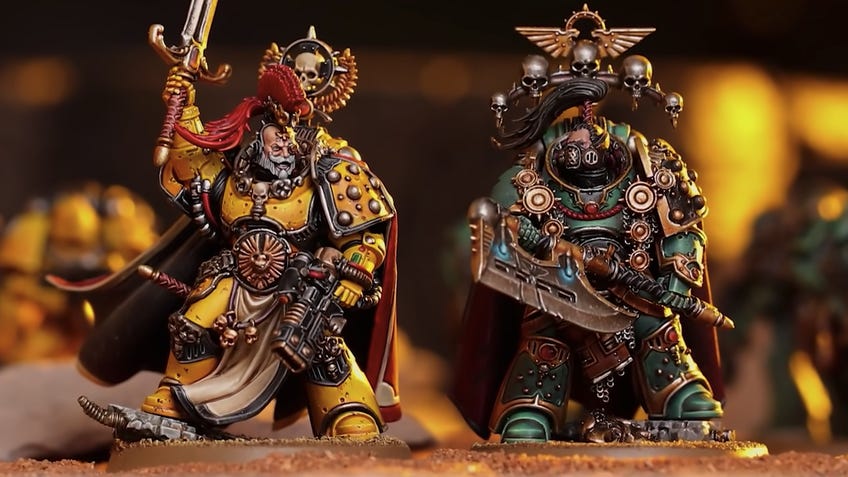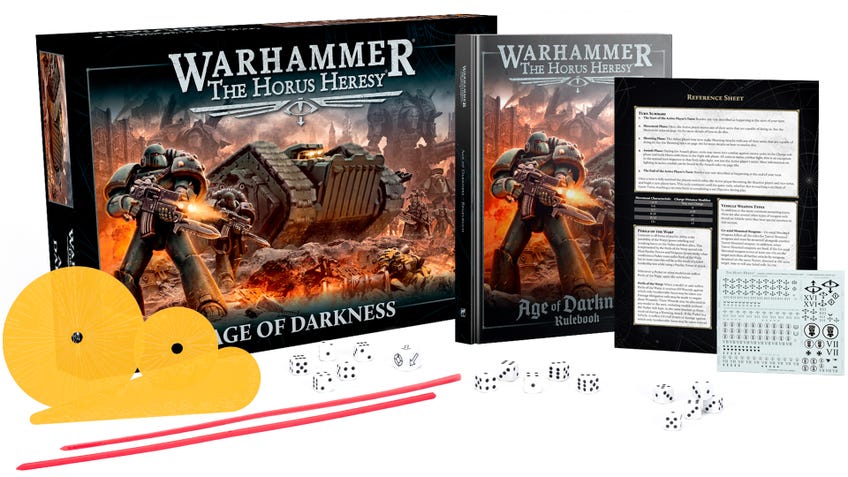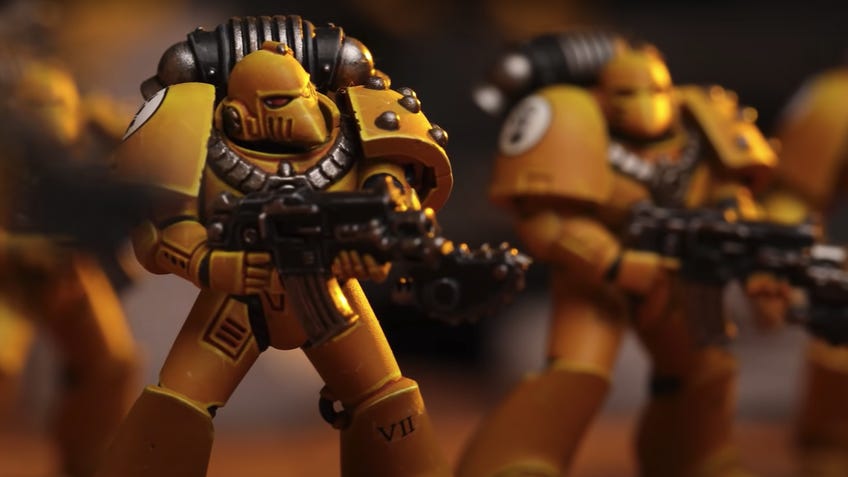Warhammer: The Horus Heresy - Age of Darkness review - a perfect introduction to the 40K spin-off
Horus-h to find it.
The Horus Heresy has been kicking around in tabletop game form for a decade now but it’s always been tucked away in its own little corner. Other than a couple of limited run, standalone releases that featured some of the bread-and-butter units in plastic, the Warhammer 40,000 spin-off known as 30K has been the exclusive domain of Games Workshop’s specialist Forge World imprint and only available in fiddly, expensive resin form.
Now it’s being pushed into the limelight with a new edition, massive plastic miniature support and a prime spot on the main GW website and in stores alongside Warhammers Age of Sigmar and 40K. Leading the charge is the massive Age of Darkness starter box.
So, what’s in the box? For starters, there’s a whole lot of plastic. 40 Tactical Space Marines, ten Cataphractii Terminators, a Contemptor Dreadnought, two Praetors and a Spartan Assault Tank. Quickly translated: that’s regular troops, chunky elite troops, a big stompy robot, a couple of leaders and, well, an assault tank. With the exception of the Terminators, these are all brand new miniatures and they are absolutely fantastic. GW arguably makes the best minis in the business and the designers have clearly used every bit of know-how they possess on these models.
The Tactical Marines are quick and simple to build - although they do need glue, there’s no push-fit here - and are equally easy to paint. Exactly what you want in your line troops! They also come with a bunch of optional parts, variant heads and the usual upgrade parts for sergeants and the like. My personal favourite has to be the chainsaw bayonets, which are just about the most Warhammer thing imaginable. As an older kit, the Terminators aren’t quite as good as the rest of the models. However, they’re still nice looking designs with a few different build options.
Replacing the notoriously stiffly-posed existing kit, the Contemptor Dreadnought more than makes up for the shortcomings of its predecessor. There are ball joints all over the place and deep knee and elbow bends, allowing for some really dynamic poses. This makes it a little trickier to assemble than the other models in the box, but the flexibility is worth it. Again, there are a bunch of weapon options and the attachment points in the elbows have clearly been designed with magnetisation in mind. With 4x1mm and 4x2mm magnets and a little superglue, you can create secure, swappable weapons with no drilling or other faffing about required.
The new Warhammer 30K is a leaner, meaner proposition, stripping out all the excess stuff while tightening and modernising everything left.
The Spartan is a big, beefy tank in that classic boxy Space Marine style. There’s a detailed interior with opening hatches if you’re into that sort of thing. As you’d probably expect for such a large vehicle, it does take a while to put together, but it’s a darn sight easier than a big block of Forge World resin.
The two Praetor models are, for my money, the stars of the show. Built as-is, they’re lovely, characterful models in their own right, with all the detail you’d want from your army leader, without being overly fussy. Their real strength lies in how easily they can be converted into something a little more bespoke. While many of GW’s character minis are assembled in quite convoluted ways, making modification a tricky prospect, these are more straightforward, making arm and head swaps relatively simple. As someone who only really started converting miniatures last year, I’ve been able to make some unique characters with these kits, and mine aren’t a patch on some of the imaginative creations I’ve already seen online.

As well as the mountains of sprues, the other main component of the Age of Darkness box is the rulebook, although that term does it something of a disservice. It’s a hefty tome, a 336-page hardback behemoth, full colour throughout and printed on some of the thickest, lushest paper stock I’ve seen in a gaming product. It’s pretty intimidating, especially if you’re not used to GW-style rulebooks, but a quick flick through reveals that almost half the book is background material and the core rules themselves take up a mere 50 pages. The rest of the page count is taken up with special rules, more detailed explanations and some gorgeous photographs of armies and battlefields to serve as inspiration.
The other printed materials in the box include two reference sheets for use during play, a sheet of transfers covering the Sons of Horus and Imperial Fists Space Marine Legions, and a black-and-white instruction booklet for building the miniatures that also contains the stats and specific special rules for all the models in the box. Finally there are all the gubbins you need to actually play the game, including dice, some templates in a rather fetching translucent orange plastic and two measuring sticks. These are the old-school “whippy sticks” that date back to the original Necromunda box from 1994 and seem to be an inclusion based on nostalgia as opposed to any kind of real utility, as you’ll still need a tape measure for anything beyond a medium-range weapon.

It’s an impressive package, but we all know that it’s what you do with it that counts. Thankfully, it turns out that Warhammer: The Horus Heresy is a bloody good game. This is the second edition of 30K, which was in turn based on the seventh edition of Warhammer 40,000. While the first edition was very much a creaky extension to a bloated ruleset, the new 30K is a leaner, meaner proposition, stripping out all the excess stuff that wasn’t relevant to the specific conflict the game is meant to portray, while tightening and modernising everything left.
The Horus Heresy has a certain elegance and intuitiveness that is lacking from modern 40K.
The result is a curious beast. It’s still very much Warhammer with all the buckets of dice and reams of special rules that entails; if you’re looking for simple, fast skirmish fun, you won’t find it here. On the other hand, it has a certain elegance and intuitiveness that is lacking from modern 40K. While the eighth and ninth editions of the game did cut a lot of unnecessary complexity from the rules, they added a lot more with byzantine webs of army-specific secondary objectives and stratagems
Horus Heresy does away with so much of that. Turns have been reduced to three phases a piece - movement, shooting and assault - with psychic powers being used when they’re relevant, rather than in a dedicated phase. Both primary and secondary objectives are determined by the mission itself (of which there are six in the book, along with six different deployment maps, providing 36 different ways in which two armies can face off against each other) and the shenanigans of stratagems have been replaced with reactions.

Reactions are the biggest addition to the game and by far my favourite. They’re designed as a counter to the potential downtime that exists in games that use the “I go, you go” turn structure. If you’ve ever played a large game of Warhammer, especially the older incarnations, you’ll know that much of your opponent’s turn consists of them doing stuff while you just make the occasional saving throw. It means you can spend half the game bored, which is no fun at all.
The core reaction rules in Horus Heresy are nice and simple. In each phase of your opponent’s turn, you can make one reaction with one of your units. In the movement phase, you can advance upon or withdraw from an enemy unit that gets close. Shooting can be responded to by either hunkering down in an effort to reduce the damage you take, or simply returning fire. Units that find themselves on the receiving end of a charge during the assault phase can either unleash a volley of short-range shots, or attempt to disrupt the charge, removing the usual benefits that their attackers would have in the ensuing combat.
Not only do these reactions keep a player engaged during their opponent’s turn, they add a hugely impactful strategic layer to the game. You can no longer fire upon an opposing unit safe in the knowledge that the worst that can happen is that you just miss. The order in which you move your units has new importance, because a quick withdrawal can mess up your carefully laid plans. In one game, my cunning opponent used the opportunity granted by my approaching Praetor to advance his Dreadnought right out of my Spartan’s line of fire.
I’ve played several games of 30K now and each time, whether playing with experienced Warhammerers or complete newbies, we’ve all found the game surprisingly easy to pick up and understand. Don’t get me wrong, there’s still been plenty of page-flipping, but it’s always been to look up a specific rule, rather than to figure out what the heck we were supposed to be doing. There’s much less to hold in your head at once, leaving you free to be engaged with the game and make strategic decisions - rather than worrying you’re going to forget some crucial special ability or stratagem. And since the vast majority of the special rules are generic, rather than specific to the unit or weapon involved, it’s much easier to slowly build up your knowledge of the game and speed up play. By the end of my first game with my partner, who I’m sure won’t mind me saying is notoriously bad at remembering rules, especially the specific numbers involved, they were cruising through firefights and melees without having to look anything up.

If the Age of Darkness box has one weakness, it’s that it isn’t a great standalone product. While all the promotional photography shows the miniatures from the box painted up as two opposing forces, they’re hard to break down into balanced armies. Even working out a much more even split than that depicted by GW, the presence of the Spartan tank in particular throws things way out of whack. There’s also no support in the core rules for this kind of smaller game. While the latest issue of GW’s White Dwarf magazine does contain a set of “Zone Mortalis” rules for games fought in denser terrain, like the inside of a spaceship or a trench network, that does scale down as low as 500 points a side (a force that would consist of roughly one-quarter to one-third of the contents of the Age of Darkness box) it’s still an additional purchase.
Also missing is any kind of army list for models not included in the box. For those, as well as the rules for the individual Space Marine Legions, you’ll need to pick up the Liber Astartes or Liber Hereticus books. This probably won’t come as a surprise to Warhammer veterans, but anyone unfamiliar with GW’s business model may be caught off guard.
Age of Darkness is a fantastic starting point for a great game.
This one caveat aside, Warhammer: The Horus Heresy - Age of Darkness is a fantastic starting point for a great game. While pricey, you get a lot for your money - and there’s always the option of splitting with a friend if you want to cut down on your initial outlay. The miniatures are top-notch, with the added value of also being usable in 40K, and there’s enough to have a respectable army without any additional purchases.
Horus Heresy veterans can look forward to the injection of new blood GW’s big push will bring, along with lots of new plastic kits already available and more on the way. The not-so-far future may still be grim, but from where I’m standing, it looks pretty bright.



